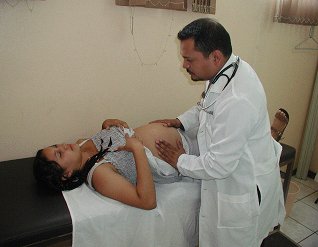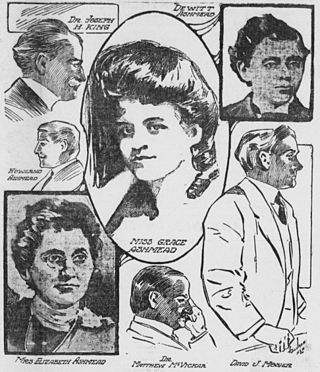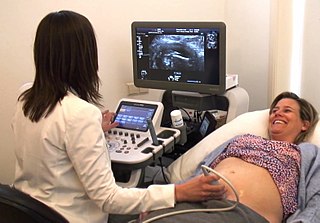
Prenatal care, also known as antenatal care, is a type of preventive healthcare. It is provided in the form of medical checkups, consisting of recommendations on managing a healthy lifestyle and the provision of medical information such as maternal physiological changes in pregnancy, biological changes, and prenatal nutrition including prenatal vitamins, which prevents potential health problems throughout the course of the pregnancy and promotes the mother and child's health alike. The availability of routine prenatal care, including prenatal screening and diagnosis, has played a part in reducing the frequency of maternal death, miscarriages, birth defects, low birth weight, neonatal infections and other preventable health problems.

A doula is a trained professional who provides expert guidance for the service of others and who supports another person through a significant health-related experience, such as childbirth, miscarriage, induced abortion or stillbirth, as well as non-reproductive experiences such as dying. A doula may also provide support to the client's partner, family, and friends.
A birthing center is a healthcare facility, staffed by nurse midwives, midwives and/or obstetricians, for mothers in labor, who may be assisted by doulas and coaches. The midwives monitor the labor, and well-being of the mother and the baby during birth. Doulas can assist the midwives and make the birth easier. Should additional medical assistance be required, the mother can be transferred to a hospital. This transfer is more likely if an epidural is needed, there is meconium staining, it is a prolonged labor, or the newborn needs intensive care. Some hospitals have birth centers as an alternative to the usual high tech maternity wards.

Surrogacy is an arrangement, often supported by a legal agreement, whereby a woman agrees to delivery/labour on behalf of another couple or person, who will become the child's parent(s) after birth. People may seek a surrogacy arrangement when a couple do not wish to carry a pregnancy themselves, when pregnancy is medically impossible, when pregnancy risks are dangerous for the intended mother, or when a single man or a same sex couple wish to have a child.
Pregnancy discrimination is a type of employment discrimination that occurs when expectant women are fired, not hired, or otherwise discriminated against due to their pregnancy or intention to become pregnant. Common forms of pregnancy discrimination include not being hired due to visible pregnancy or likelihood of becoming pregnant, being fired after informing an employer of one's pregnancy, being fired after maternity leave, and receiving a pay dock due to pregnancy. Pregnancy discrimination may also take the form of denying reasonable accommodations to workers based on pregnancy, childbirth, and related medical conditions. Pregnancy discrimination has also been examined to have an indirect relationship with the decline of a mother's physical and mental health. Convention on the Elimination of All Forms of Discrimination against Women prohibits dismissal on the grounds of maternity or pregnancy and ensures right to maternity leave or comparable social benefits. The Maternity Protection Convention C 183 proclaims adequate protection for pregnancy as well. Though women have some protection in the United States because of the Pregnancy Discrimination Act of 1978, it has not completely curbed the incidence of pregnancy discrimination. The Equal Rights Amendment could ensure more robust sex equality ensuring that women and men could both work and have children at the same time.

Birth tourism is the practice of traveling to another country or city for the purpose of giving birth in that country. The main reason for birth tourism is to obtain citizenship for the child in a country with birthright citizenship. Such a child is sometimes called an "anchor baby" if their citizenship is intended to help their parents obtain permanent residency in the country. Other reasons for birth tourism include access to public schooling, healthcare, sponsorship for the parents in the future, or even circumvention of China's two-child policy. Popular destinations include the United States and Canada. Another target for birth tourism is Hong Kong, where some mainland Chinese citizens travel to give birth to gain right of abode for their children.
Pregnant patients rights refers to the choices and legal rights available to a woman experiencing pregnancy or childbirth. Specifically those under medical care within a medical establishment or those under the care of a medical professional regardless of location.
The Baby Scoop Era was a period in anglosphere history starting after the end of World War II and ending in the early 1970s, characterized by an increasing rate of pre-marital pregnancies over the preceding period, along with a higher rate of newborn adoption.

Hutzel Women's Hospital is one of the eight institutions that compose the Detroit Medical Center. The hospital itself is connected to Harper University Hospital, on the midtown Detroit campus of the Medical Center. It is the only hospital in Southeast Michigan dedicated to women's care. As Michigan’s first and only hospital for women, Hutzel Women’s Hospital has been The Destination for Women’s Care since 1868.

Child harvesting or baby harvesting refers to the systematic sale of human children, typically for adoption by families in the developed world, but sometimes for other purposes, including trafficking. The term covers a wide variety of situations and degrees of economic, social, and physical coercion. Child harvesting programs or the locations at which they take place are sometimes referred to as baby factories or baby farms.
The Gladney Center for Adoption in Fort Worth, Texas, US, provides adoption and advocacy services. Following its 1880s origins, when it focused on locating homes for orphans during a period of mass migration. It evolved into lobbying, international adoptions, counseling, maternity services, education and philanthropy.

Like many developing countries, Uganda has high maternal mortality ratio at 343 per 100,000 live births. According to the World Health Organization (WHO), a maternal death is the death of a woman while pregnant or within 42 days of termination of pregnancy, irrespective of the duration and site of the pregnancy, from any cause related to or aggravated by the pregnancy or its management but not from accidental or incidental causes. In situations where attribution of the cause of death is inadequate, another definition, pregnancy-related death was coined by the US Centers for Disease Control (CDC), defined as the death of a woman while pregnant or within 42 days of termination of pregnancy, irrespective of the cause of death.

Pradhan Mantri Matru Vandana Yojana (PMMVY), previously known as the Indira Gandhi Matritva Sahyog Yojana, is a maternity benefit program run by the government of India. It was originally launched in 2010 and renamed in 2017. The scheme is implemented by the Ministry of Women and Child Development. It is a conditional cash transfer scheme for pregnant and lactating women of 19 years of age or above for the first live birth. It provides a partial wage compensation to women for wage-loss during childbirth and childcare and to provide conditions for safe delivery and good nutrition and feeding practices. In 2013, the scheme was brought under the National Food Security Act, 2013 to implement the provision of cash maternity benefit of ₹6,000 (US$75) stated in the Act. Presently, the scheme is implemented on a pilot basis in 53 selected districts and proposals are under consideration to scale it up to 200 additional 'high burden districts' in 2015–16. The eligible beneficiaries would receive the incentive given under the Janani Suraksha Yojana (JSY) for Institutional delivery and the incentive received under JSY would be accounted towards maternity benefits so that on an average a woman gets ₹6,000 (US$75)
Commodification of the womb is a Marxist concept related to the sale of functions performed by the human uterus.

A midwife is a health professional who cares for mothers and newborns around childbirth, a specialization known as midwifery.
The maternal mortality rate is 224 deaths per 100,000 births, which is the 23rd highest in the world. The mean age of mothers at birth is 19.3 years old, and the fertility rate is 5.72 children born per woman, which is the 7th highest in the world. The contraceptive rate is only 40.8%, and the birth rate is the 4th highest in the world at 42.13 births/1,000 population. Infectious disease is a key contributor to the poor health of the nation, and the risk is very high for diseases such as protozoal and bacterial diarrhea, hepatitis A, typhoid fever, malaria, dengue fever, schistosomiasis, and rabies. The adult prevalence rate of HIV/AIDS is 12.37%, which is the 7th highest in the world.
Birth mothers in South Korea (international adoption) refers to the group of biological mothers whose children were placed for adoption in South Korea's international adoption practice. The decades-long phenomenon of international adoption in South Korea began after the Korean War. In the years since the war, South Korea has become the largest and longest provider of children placed for international adoption, with 165,944 recorded Korean adoptees living in 14 countries, primarily in North America and Western Europe, as of 2014.
The Milford Industrial Home, formerly called Nebraska Maternity Home, was an institution in Milford, Nebraska, which housed unmarried pregnant women. For a while it was the only such institution in the country. It was founded by an act of the Nebraska Legislature in 1887, and the first woman was admitted in 1889. The women were under strict rules, and were encouraged to place their babies for adoption. They stayed there, usually under court order, for a period of a year. The home closed in 1954; it is estimated that over 4,000 babies were born there.
Eunice Mary Eichler was a New Zealand Salvation Army officer, nurse and midwife. She established New Zealand's first school for pregnant teenagers in 1973, and was an advocate for open adoption.








